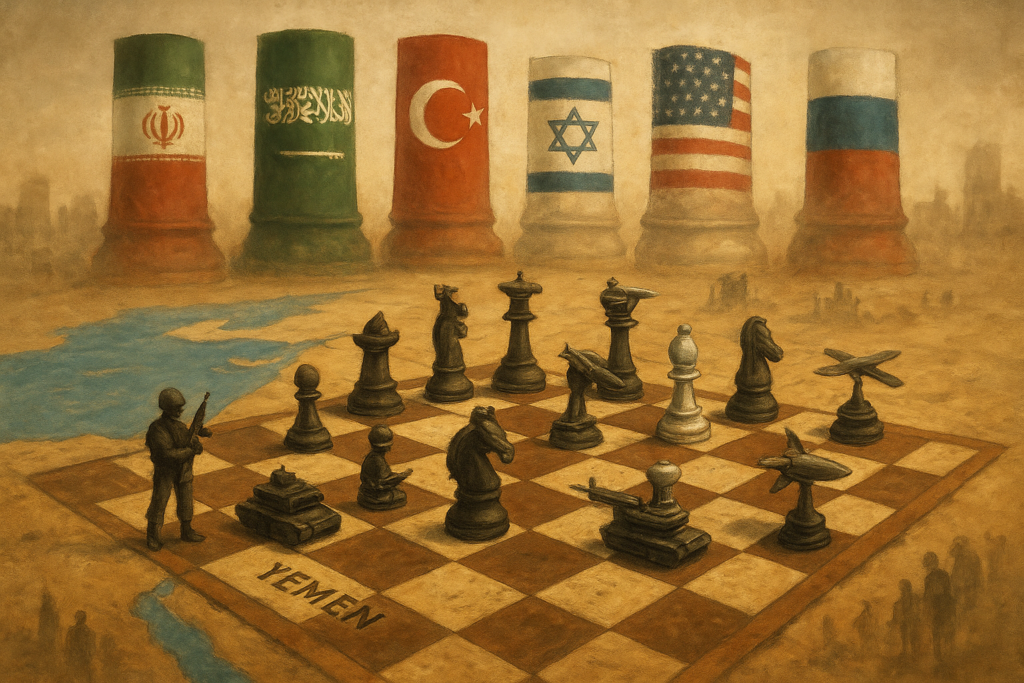
- Proxy warfare in the Middle East allows powerful states and non-state actors to advance interests through local allies, militias, or allied states without deploying large conventional forces, offering cost-effectiveness, plausible deniability, and influence without occupation.
- Yemen’s conflict, rooted in political exclusion and economic inequality, has evolved into a geostrategic proxy battle between Iran-backed Houthis and a Saudi-led coalition, with devastating humanitarian consequences including famine, displacement, and disease.
- Syria’s civil war became one of the most complex proxy wars in modern history, with multiple foreign sponsors backing opposing sides, creating overlapping conflicts, a “conflict economy,” and a stalemate that persists due to divergent sponsor interests.
- In Lebanon, Hezbollah operates simultaneously as a political party, social welfare provider, and Iranian-backed militia, creating dual power zones and posing both stabilising and destabilising effects on the country’s security.
Proxy warfare is the science, or better still, the bane of making someone else do the fighting. It is used by a strong state or non-state actor of local allies, militias or allied states to advance its interests without deploying significant conventional forces. Sponsors bankroll, arm, train and counsel proxies, sometimes disclaiming direct responsibility.
Proxy War and the Middle East
In the Middle East, proxy warfare is not unusual; it is part of the political and military structure of the region. Since the 1970s, and particularly since the 2003 US invasion of Iraq and the 2011 Arab revolts, the region has been a chessboard on which competing states such as Iran, Saudi Arabia, Turkey, and Israel, along with outside powers such as the United States and Russia, have placed their pieces.
The reasons are obvious:
- Cost-effectiveness: Less expensive than stationing national armies.
- Plausible deniability: Enables sponsors to deny direct responsibility.
- Leverage without occupation: Influence outcomes without literally occupying territory.
The dangers are similarly self-evident:
- Proxies form their agendas.
- Fights persist longer than they would otherwise.
- Civilians suffer – displacement, hunger, disease, and the devastation of infrastructure.
Here we analyse three representative cases, Yemen, Syria and Lebanon, illustrating how local grievances served as battlegrounds for regional and international rivalries. Each case contains a timeline, a map context description, and actor tables to present an overall picture.
The Proxy War of Yemen – The “Forgotten” Conflict at the Red Sea’s Intersection
Background
The war in Yemen started as a domestic dispute stemming from regional marginalisation, political exclusion, and economic inequality. Since the early 2000s, the central government has been at odds with the Houthi movement (Ansar Allah), a Zaidi Shi’a group from the northern province of Saada. President Abdrabbuh Mansur Hadi failed to stabilise the country after President Ali Abdullah Saleh was overthrown during the Arab Spring of 2011.
The Houthis captured Sanaa, the capital, by September 2014. When Hadi fled to Saudi Arabia in early 2015, the coalition led by Saudi Arabia (Bahrain, the United Arab Emirates, etc.) intervened militarily.
Timeline — Yemen
| Year | Event |
|---|---|
| 2014 | Houthis seized Sanaa, forcing the Hadi government to flee. |
| 2015 | Saudi-led coalition launches air campaign; UAE forces land in southern Yemen. |
| 2017 | Former President Saleh was killed after breaking with the Houthis. |
| 2018 | Battle for Hodeidah port — vital humanitarian entry point. |
| 2019 | Drone and missile strikes hit Saudi oil facilities (claimed by Houthis). |
| 2020–2022 | Sporadic ceasefires amid COVID-19 and rising famine risk. |
| 2023–2024 | Houthi attacks on Red Sea shipping escalate, disrupting global trade. |
If it were mapped, Yemen’s proxy war would reveal the Houthis dominating the north and capital, the Saudi-backed government with pockets in the south, and UAE-backed separatists commanding areas of Aden and its environs. The Red Sea coastline becomes a strategic prize, both in terms of commerce and military choke points.
Key Actors in Yemen
| Actor | Role | External Support |
|---|---|---|
| Houthis (Ansar Allah) | The rebel movement is controlling northern Yemen | Iran (arms, training, drones) |
| Saudi-led Coalition | Military alliance to restore Hadi’s government | Saudi Arabia, the UAE, and the US logistical aid |
| Southern Transitional Council (STC) | Secessionist movement in the South | UAE |
| Internationally Recognised Gov. | Nominal central authority | Saudi Arabia |
Yemen’s war is geostrategic as well as ideological. For Iran, backing the Houthis seeks to push Saudi Arabia southward. For Riyadh, the war is to preclude an Iranian presence close to the Bab el-Mandeb Strait, an oil shipment chokepoint.
With over 150,000 direct and indirect deaths, millions of displaced people, widespread famine and cholera outbreaks, the humanitarian toll is astounding. The war’s proxy nature ensures that patrons’ strategic interests will continue to fuel the conflict even in cases where indigenous actors are open to negotiating.
Across Yemen, Syria, and Lebanon, common patterns include regional rivalry (especially Iran–Saudi Arabia), proxy autonomy, severe humanitarian crises, prolonged intractable conflicts, and the collapse of settlements without sponsor involvement.
Covert Conflict in Syria: The Proxy Super-Market
Background
The Arab Spring-style nonviolent protests that preceded Syria’s civil war began in 2011. The uprising was militarised by the government’s brutal suppression. It quickly rose to the status of the most intricate proxy war in modern history.
The US, Turkey, and Gulf states armed different opposition groups, while Iran and Russia supported Bashar al-Assad’s government. To defeat ISIS, the US allied with the Kurdish-led Syrian Democratic Forces (SDF). Additional instability was caused by extremist organisations like ISIS and Jabhat al-Nusra, an affiliate of al-Qaeda.
Timeline — Syria
| Year | Event |
|---|---|
| 2011 | Peaceful protests begin; government repression escalates. |
| 2012–2013 | Free Syrian Army forms; influx of foreign fighters. |
| 2014 | ISIS captures Raqqa, declaring a “caliphate.” |
| 2015 | Russia intervenes militarily, turning the tide for Assad. |
| 2017 | SDF, backed by the US, retakes Raqqa from ISIS. |
| 2018–2019 | Turkey launches operations against Kurdish forces. |
| 2020–2024 | Frontlines freeze; sporadic clashes continue. |
A map of the Syrian conflict would display a patchwork: Assad’s regime dominating the west and large cities; Turkish-backed factions in the northwest; the SDF, led by Kurds, in the northeast; pockets of rebel faction remnants in Idlib; and small ISIS cells in the desert.
Key Actors in Syria
| Syrian Government | Regime led by Bashar al-Assad | Russia, Iran, Hezbollah |
| Syrian Democratic Forces (SDF) | Kurdish-led coalition | United States |
| Opposition Forces | Varied anti-Assad rebels | Turkey, Gulf states |
| ISIS | Extremist jihadist group | Self-funded through oil, extortion |
Syria demonstrates how several concurrent, overlapping proxy wars can generate a “conflict economy.” Warlords gain from smuggling, diversion of aid, and control of resources. Proxies frequently act semi-autonomously, sometimes fighting against their sponsors’ other allies (e.g., US-backed Kurds vs. Turkish-backed rebels).
Russia’s aerial campaign and Iran’s ground proxies guaranteed Assad’s survival but left Syria shattered. A political resolution remains distant because sponsors’ interests differ: the US wants counter-terrorism, Turkey worries about Kurdish independence, Iran desires a corridor to Lebanon, and Russia seeks a permanent base on the Mediterranean.
Shadow War in Lebanon: The Long-Term Proxy
Background
Lebanon is unique in that the proxy has infiltrated the state itself. Founded in 1982 with Iranian support, Hezbollah functions as a social welfare organisation, a political party and a heavily armed militia. Even though there hasn’t been a major conflict in Lebanon since 2006, Hezbollah’s military presence, its involvement in Syria, and its conflicts with Israel make it a constant flashpoint in the Iran-Israel conflict.
Timeline — Lebanon
| Year | Event |
|---|---|
| 1982 | Hezbollah was formed during the Israeli invasion. |
| 1990s | Consolidates power; engages in guerrilla war against Israel. |
| 2000 | Israel withdraws from southern Lebanon. |
| 2006 | The Hezbollah–Israel war devastates infrastructure. |
| 2013–2017 | Hezbollah fights in Syria to support Assad. |
| 2023–2024 | Cross-border tensions with Israel rise amid Gaza war spillover. |
Hezbollah’s power is focused on the south (alongside Israel) and sections of Beirut and the Bekaa Valley on a map of Lebanon. Its influence coincides with areas defined by official Lebanese Armed Forces zones, creating dual power zones.
Key Actors in Lebanon
| Actor | Role | External Support |
|---|---|---|
| Hezbollah | Shia political party and militia | Iran |
| Lebanese Armed Forces | National army | US, France |
| Israel | Regional adversary | — |
Hezbollah’s double identity, part of the government but obligated to Iran, is stabilising (as a check on ISIS and others) and destabilising (chance of dragging Lebanon into regional conflicts). Disarming Hezbollah is a political impasse and threatens civil war.
Cross-Case Patterns
- Regional Rivalry: Iran and Saudi Arabia are the main sponsors.
- Proxy Autonomy: Militias forge independent agendas.
- Humanitarian Consequences: Blockades, sieges, and manipulation of aid are routine.
- Intractable Conflict: Wars drag on even after static frontlines emerge.
- Diplomatic Nuance: Settlements collapse without involving sponsors.
Conclusion
Proxy wars in the Middle East succeed because they are expedient for powerful states’ strategic interests. But Lebanon, Syria, and Yemen show that these wars don’t end on their own. They leave behind fractured states, broken societies, and generations of citizens who have only ever experienced instability. Resolution is only possible if the regional rivalries and local grievances that fuel these proxy wars are addressed.
Daljeet Singh holds a BTech in Computer Science and is currently pursuing an MA in Political Science. His interests range across geopolitics, international relations, and technology. An avid reader and writer, he is passionate about exploring the intersections of these fields. Views expressed are the author’s own.
